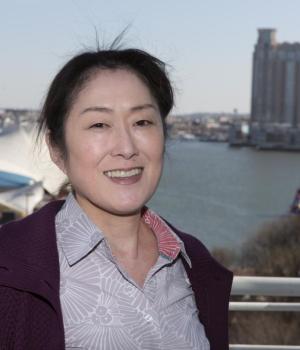
Keiko Saito
Research Interests
- Aquatic microbial ecology and aquacultural microbiology
- Anaerobic ammonium-oxidizing bacteria (anammox) and ammonia-oxidizing archae (AOA) for waste treatment in marine recirculating aquaculture systems (RAS)
My research focuses on aquatic microbial ecology and aquacultural microbiology - many significant ocean/marine processes are known to be mediated by microorganisms. Since most microorganisms in the natural environment have yet to be cultivated, I apply molecular approaches to link the critical roles of microbial community composition, functional diversity, ecosystem processes, and bio-degradation/remediation.
My studies, moreover, comprise the development and improvement of microbial mediated waste treatment technologies for next-generation aquaculture practices. Aquaculture, in common with all methods of food production, creates challenges for environmentally sound and sustainable operation. Awareness of potential negative impacts on the environment by organic and inorganic pollution discharges of fish farms has significantly increased along with aquaculture industry growth. To respond to these problems, DMB's scientists have developed the near zero-discharge, land-based recirculating aquaculture system (RAS), integrating microbial-mediated processes for its waste treatment. Our RAS conserves and treats water and solid wastes to remove inorganic and organic pollutants, while maintaining healthy water quality for fish-rearing in recycled water. Unlike the traditional aquaculture practice of growing fish outdoors in open ponds and net cages, RAS allows for fish to be raised in a controlled environment inside a building separated from natural environment. Tailored culture conditions accelerate growth and improve feed-conversion rates at high stock densities, and RAS also offers a high biosecure standard, along with environmental sustainability.
The microbial processes used for waste treatment is one of the most important RAS characteristics. For example, in the 'closed' recirculating system, toxic ammonia - the end product of protein metabolism by fish and the decomposition of feces and uneaten feed - is oxidized into non-toxic nitrate, via nitrite, by nitrification bofilteration mainly driven by chemolitho-autotrophic ammonia-oxidizing bacteria (AOB) such as Nitrosomonas and Nitrosospira spp. and AOA. Commonly used land-based systems in aquaculture industry, so-called partial reuse RASs, accumulate nitrate as a result of nitrification. Therefore, these systems require daily water exchange (10-50% of total system) to maintain healthy nitrate level. Instead, UMBC-DMB's RAS eliminates nitrate by autotrophic and heterotrophic denitrification and anammox processes via a 'denammox' (denitrification-anammox) reactor and reuses virtually 100% of culture water for fish production. Moreover, our RAS integrates anaerobic biodegradation of organic solid wastes to reduce organic pollution discharge and recycles bio-energy by methane biogas production. These microbial processes employed in our RAS are natural processes. I study RAS microbial ecology to understand microbial community composition and processes and advance RAS technology to further transform aquaculture toward sustainable and green food production.
